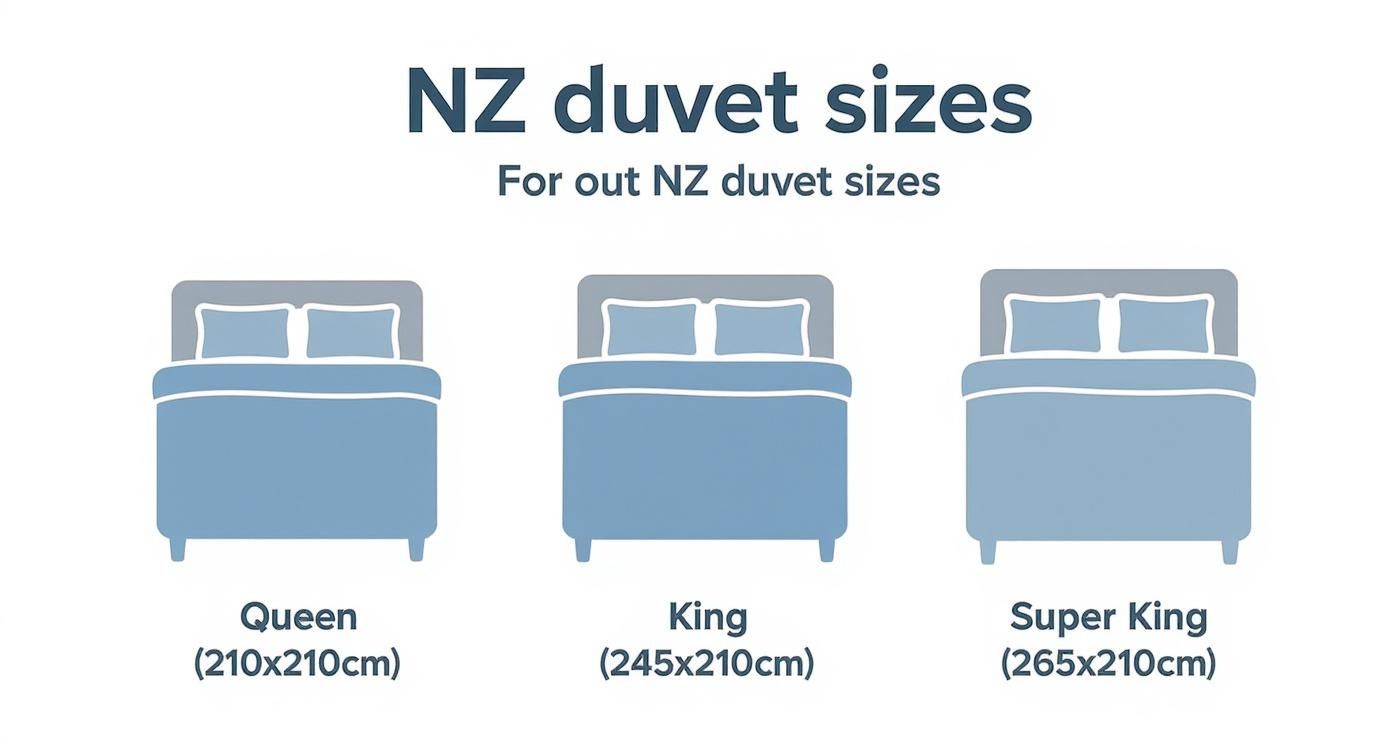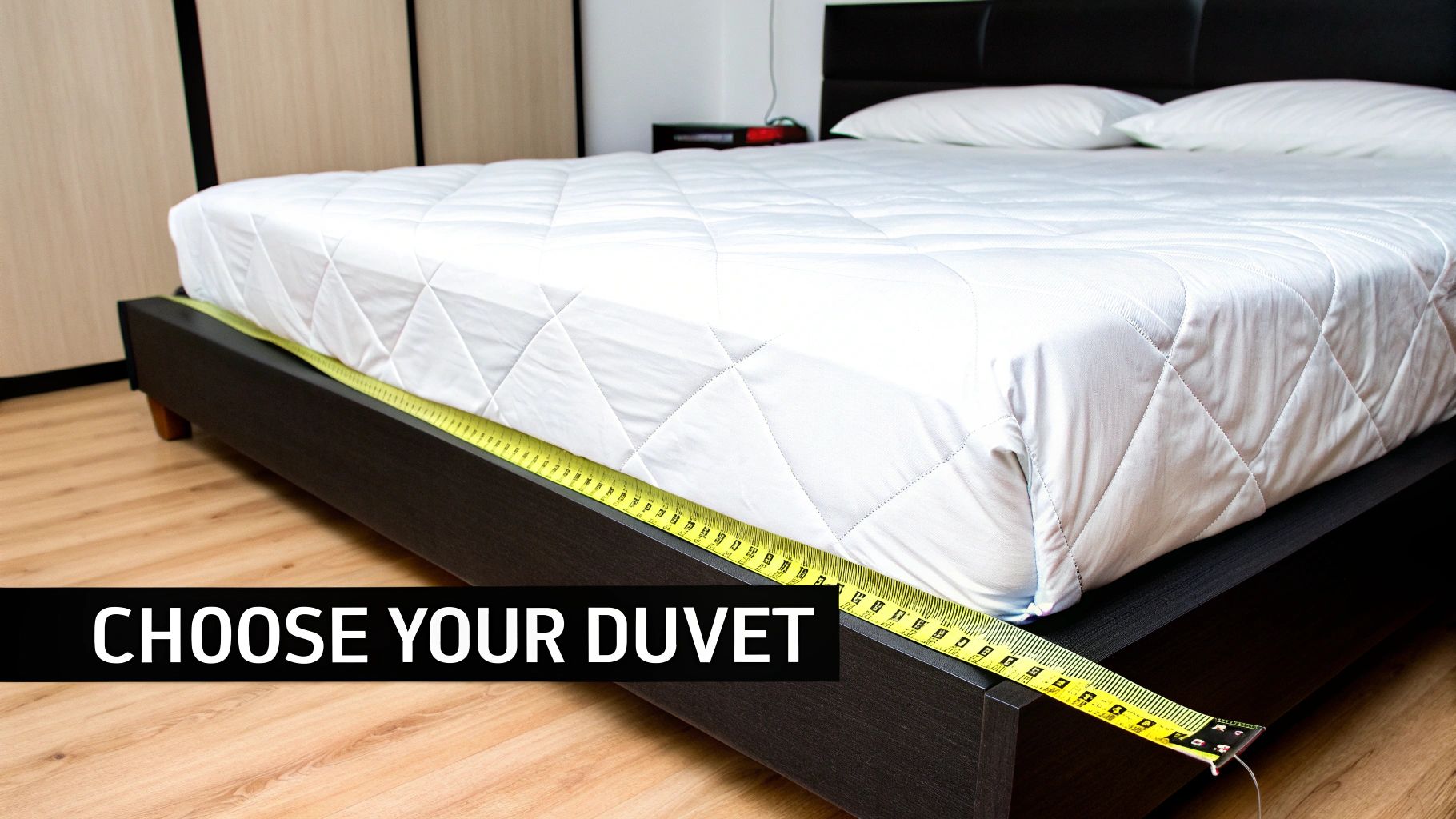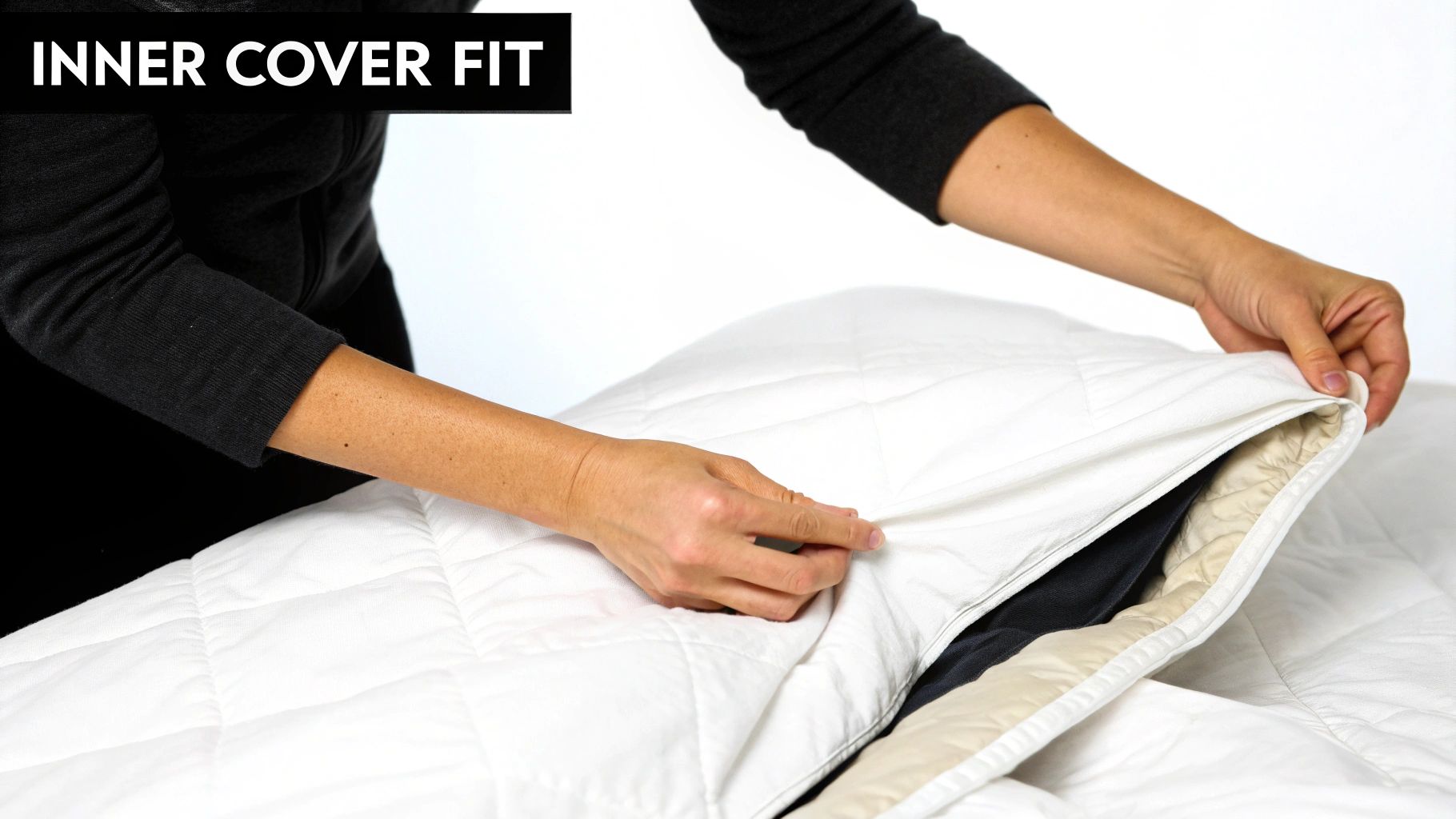Picking the right duvet here in New Zealand really comes down to knowing the standard dimensions. We have our own unique sizes, from a Single (140 x 210cm) and Queen (210 x 210cm) right up to a Super King (265 x 210cm). Each one is designed to give you a lovely, generous overhang on our standard Kiwi mattresses.
Your Instant NZ Duvet Size Chart
Getting the right duvet is the first step to a great night's sleep and a beautifully made bed. It can be a bit confusing because, while our duvet sizes are made to fit our local mattresses, the measurements aren't exactly the same. This can lead to a bit of head-scratching.
To make it simple, I've put together a clear, straightforward chart. Think of it as your cheat sheet for all things bedding. It gets rid of the guesswork and helps you match your mattress to the perfect duvet inner and cover every time.
Official New Zealand Duvet and Duvet Cover Size Chart
Here’s a quick-reference table outlining all the standard duvet and duvet cover sizes you'll find in New Zealand. Use it to find the perfect fit for your bed and achieve that polished, inviting look you're after.
| NZ Duvet Size | Duvet Inner / Cover Dimensions (cm) | Typical NZ Mattress Size (cm) |
|---|---|---|
| Single | 140cm x 210cm | 92cm x 188cm |
| King Single | 180cm x 210cm | 107cm x 203cm |
| Double | 180cm x 210cm | 137cm x 188cm |
| Queen | 210cm x 210cm | 153cm x 203cm |
| King | 245cm x 210cm | 167cm x 203cm |
| Super King | 265cm x 210cm | 183cm x 203cm |
| Californian King | 270cm x 240cm | 203cm x 203cm |
With this table, you can see at a glance how much wider the duvet is than the mattress it’s designed for, ensuring you get that perfect drape down the sides.

This visual is a handy way to see the difference between our most popular sizes. Notice how the length for most standard duvets remains consistent at 210cm—it’s the width that really grows as you size up.
How to Use This Guide
While this chart gives you the core numbers, creating that truly luxurious, hotel-style bed often involves a bit more than just matching the size name. For instance, you’ll notice both a King Single and a Double bed often use the same 180 x 210cm duvet. This works, but it gives the Double bed a much snugger fit compared to the generous drape on the King Single. It’s all about the look you prefer.
For a deeper dive into getting the pairing just right, you can explore our detailed guide on duvet cover sizes. We'll also get into choosing the perfect overhang, comparing our local sizes to international ones, and tips for keeping your bedding in top shape.
A Closer Look at Standard NZ Bedding Dimensions
Getting the dimensions right is the first step to a perfectly made bed. But it's about more than just numbers on a chart. Every size has a purpose, designed for the different spaces in our homes and the way we sleep. From a child's first 'big bed' to a sprawling master suite, let's unpack the details of each standard New Zealand size.

It makes sense that New Zealand duvet sizes are directly tied to the standard mattress dimensions you find across the country. This creates a complete bedding system that just works. Historically, Kiwi mattresses standardised with lengths of about 188 cm to 203 cm. A typical single is 92 cm by 188 cm, while a queen is usually 153 cm by 203 cm. This close relationship between mattress and duvet is fundamental to how bedding is designed here in New Zealand.
Single And King Single Duvets
The Single duvet (140cm x 210cm) is the go-to for a standard single mattress. It’s perfectly scaled for kids' rooms, bunk beds, and smaller guest rooms where every centimetre counts. The fit is tidy, so you don't get heaps of fabric pooling on the floor.
Moving up, a King Single duvet (180cm x 210cm) gives you a lot more to work with. It's designed for the longer, wider King Single mattress, which is a really popular choice for growing teens or any taller individual. That extra width means even the most restless sleeper stays covered all night.
Practical Example: Think of a teenager who's shot up and outgrown their single bed. The King Single setup is a game-changer. That larger 180cm x 210cm duvet offers so much more coverage, meaning they're less likely to kick the covers off and wake up cold.
Double And Queen Duvets
Here's a classic Kiwi quirk: the standard Double duvet shares the same 180cm x 210cm dimensions as a King Single. While it definitely fits a double bed, the look is much snugger with less drape down the sides. This makes it a great, no-fuss option for smaller rooms where you might have a Double bed tucked into a corner.
The Queen duvet (210cm x 210cm) is famously square, a real signature of New Zealand bedding. This perfect symmetry gives you a balanced, generous drape on a standard Queen mattress. It's how you get that inviting, hotel-style look. It’s also the most popular size for couples, as the extra width helps put an end to the nightly tug-of-war for the covers.
King And Super King Duvets
For anyone wanting a truly spacious and luxurious sleep, the bigger sizes deliver in spades.
- King Duvet (245cm x 210cm): This size adds significant width, making sure both people in a King bed have more than enough duvet to feel cosy without disturbing each other.
- Super King Duvet (265cm x 210cm): As one of the largest standard options, the Super King is all about plush comfort. Its huge 265cm width creates a grand, opulent look that makes it the perfect centrepiece for a master bedroom.
- Californian King Duvet (270cm x 240cm): This is the biggest of the standard New Zealand duvet sizes, made specifically for the equally large, square Californian King mattress. It provides incredible coverage for an unmatched feeling of luxury.
To get a better sense of how mattresses themselves can vary, it can be helpful to read up on different bed configurations and sizes. Understanding the base you're working with is key to appreciating why specific duvet dimensions are so crucial for getting the fit and feel you're after.
How To Choose The Perfect Duvet Size
Picking the right duvet isn't just about matching the name on the tag to the size of your bed. A few other things, like how deep your mattress is and the look you're going for, are crucial for getting it just right. Nailing this is the secret to a bed that not only feels incredible but looks like it’s been styled by a pro.
Grabbing a Queen duvet for a Queen bed might sound logical, but it often won't give you the generous coverage you see in magazines, especially with the deeper, more luxurious mattresses common today. To get that perfect drape and make sure you're wrapped up warmly all night, you need to think a little bigger.
First, Check Your Mattress Depth
The biggest oversight we see is people not factoring in the height of their mattress. Modern mattresses, particularly those with plush pillow-tops or extra comfort layers, are a lot deeper than they used to be, often sitting well over 30cm high.
That extra depth eats into the width of your duvet. A standard-sized duvet on a deep mattress can end up looking skimpy, barely reaching the bottom of the mattress and leaving the sides exposed. It looks a bit unbalanced and, more importantly, can leave you wrestling for cover in the middle of the night.
The Overhang Formula For a quick way to ensure you'll have enough coverage, try this simple calculation: Mattress Width + (Mattress Depth x 2) = Minimum Duvet Width. This formula makes sure your duvet covers the top of the bed and drapes fully down both sides.
Let's take a standard NZ Queen mattress, which is 153cm wide. If you have a plush 35cm deep mattress, your maths would look like this: 153 + (35 x 2) = 223cm. A standard Queen duvet at 210cm wide just won't cut it. In this case, a King duvet (245cm wide) would be a much better fit, giving you that full, cosy coverage.
Sizing Up For A Luxurious Drape
If you’re dreaming of a plush, opulent bed that looks like it belongs in a five-star hotel, the oldest trick in the book is simply to size up. Putting a larger duvet on your bed creates a generous, flowing overhang that adds a real sense of weight and undeniable comfort.
It's a move that's both stylish and practical. This simple switch can make the bed the true centrepiece of the room, taking it from standard to absolutely stunning.
Here are a couple of go-to combinations that always work:
- For a Queen Bed: A King duvet (245cm x 210cm) is the perfect upgrade. It gives you plenty of fabric to drape beautifully over the sides, even on a very deep mattress.
- For a Double Bed: Popping a Queen duvet (210cm x 210cm) on a Double bed works wonders. It instantly makes a standard double feel far more inviting and substantial.
A Practical Tip For Couples
Looks aside, sizing up is a brilliant move for anyone who shares a bed. It's the easiest way to put an end to the nightly tug-of-war for the covers, ensuring both of you have more than enough duvet to stay warm.
A bigger duvet also means less disturbance when one person rolls over, which can lead to a much better night's sleep for everyone. It's a small change that can make a massive difference to your comfort.
Your Duvet Selection Checklist
Feeling confident? To choose the right one from all the New Zealand duvet sizes available, just run through these quick steps.
- Measure Your Mattress: Grab a tape measure and get the exact width, length, and—most importantly—the depth.
- Decide on Your Look: Are you after a neat, tidy fit, or a more luxurious, generous drape? This will tell you whether to stick to your size or go one up.
- Think About How You Sleep: If you share the bed or tend to toss and turn, sizing up is a smart, practical choice for uninterrupted comfort.
- Check the Final Dimensions: Always look at the final measurements in centimetres before you buy. Don't just rely on the name (e.g., "Queen") to guarantee you're getting the fit you really want.
NZ Duvet Sizes Vs International Standards
Ever tried buying bedding from an overseas retailer, only to get it home and find it just doesn't fit? It's a surprisingly common and frustrating experience. Because there's no global standard, what one country calls a 'Queen' or 'King' can be completely different from the New Zealand duvet sizes we're used to.
This mismatch often leads to a duvet cover that's either swimming on your inner or too small to close. The only foolproof way to get it right is to ignore the name on the label—like 'King' or 'Queen'—and focus purely on the dimensions in centimetres. It’s the secret to avoiding a costly mistake.

Key Regional Differences To Know
The main confusion for Kiwi shoppers usually comes from comparing our local sizes with those from Australia, the UK, and the USA. Each has its own sizing conventions that can easily catch you out.
- Australia vs New Zealand: While our mattress sizes are often quite similar, our duvets can vary. An Australian King mattress, for example, is wider than ours, so their duvet sizes are proportioned differently. It's a classic mistake to assume they are a perfect match.
- United Kingdom vs New Zealand: UK bed and duvet sizes are nearly always smaller than their Kiwi equivalents. A UK 'King' duvet is much narrower and won't provide nearly enough coverage for a standard NZ King bed.
- United States vs New Zealand: US sizes are a whole different ball game. Not only are the dimensions different, but they're also measured in inches, which adds another layer of conversion. Their rectangular 'Queen' and 'King' sizes simply don't align with our local standards.
International Duvet Size Conversion Chart (NZ vs. AUS, UK, USA)
To help you see the differences at a glance, we've put together this comparison table. Remember to use it as a guide and always, always check the exact centimetre measurements on the product you're buying.
| Bed Size | New Zealand (cm) | Australia (cm) | United Kingdom (cm) | United States (inches) |
|---|---|---|---|---|
| Queen | 210 x 210 | 210 x 210 | 220 x 225 | 90" x 90" (approx. 229 x 229 cm) |
| King | 245 x 210 | 245 x 210 | 230 x 220 | 104" x 90" (approx. 264 x 229 cm) |
| Super King | 265 x 210 | 270 x 240 | 260 x 220 | 114" x 98" (approx. 290 x 249 cm) |
As you can see, even a few centimetres can make all the difference between a beautiful drape and a poor fit. Here in New Zealand, our duvet sizes are designed specifically for our local mattresses. A standard NZ Queen duvet cover, for instance, is a perfect 210 cm x 210 cm square, designed for a mattress of around 153 cm x 203 cm. This is quite different from the longer, narrower American queen.
Likewise, our NZ King duvet cover is 245 cm wide by 210 cm long, and the Super King bumps that up to 265 cm—giving you that generous overhang, especially on deeper modern mattresses.
Common Mistakes And Solutions
Navigating international sizing can be a minefield, but avoiding the common traps is actually quite simple.
The single biggest mistake is buying based on the name alone. A 'King' is not a 'King' the world over. Always ignore the name and focus solely on the measurements provided in centimetres.
If you've already made a purchase and the sizing is off, don't despair just yet. A cover that's a bit too big can often be altered by a good seamstress for a custom fit. A cover that's too small, however, is much harder to fix—which really drives home the importance of measuring first.
To make sure all your bedding layers work together perfectly, have a look at our complete New Zealand bedding size chart. It's your best local reference.
A Practical Guide to Duvet Inners and Covers
Making a beautiful bed is about more than just matching the right size on the label; it’s about the relationship between your duvet inner and its cover. While they're designed to be a pair, a few expert tricks can take your bed from simply tidy to genuinely inviting. Getting this combination right is the secret to achieving that perfect blend of comfort and style.
The golden rule for a plush, full-looking bed? Make sure your duvet inner is the same size as, or even a little larger than, your duvet cover. This simple step prevents the inner from swimming around and bunching up inside—a common and annoying problem. A snug fit is what keeps everything lofty, smooth, and looking effortlessly neat.
Understanding Fill Material and Loft
What’s inside your duvet inner makes a huge difference to how it fits and feels. Different fills compress and drape in their own unique ways, which completely changes how they sit inside a cover.
- Down and Feather: As natural fills, they offer incredible loft and a light, cloud-like feel. They fill out a cover beautifully, giving you that classic, puffy hotel-bed look.
- Wool: A favourite here in New Zealand, wool inners are naturally denser and fantastic for regulating temperature. They tend to have a flatter, more streamlined profile.
- Microfibre and Synthetics: These are often engineered to feel just like down. They provide great volume, fill a cover evenly, and are an excellent choice for allergy sufferers.
To get a better sense of how all these elements come together, this complete guide to various bedding components is a great resource. It gives a practical look at how different layers and materials work in harmony to create the ideal sleep setup.
Securing Your Duvet Inner for Good
We’ve all been there: the duvet inner has slipped down inside the cover, leaving a sad, floppy flap of fabric at the top. The easiest way to fix this for good is to look for a duvet cover with internal ties in the corners.
These simple fabric ties let you secure the corners of the inner directly to the inside of the cover. It’s a small detail that makes a massive difference, keeping your duvet perfectly in place, night after night. When you're shopping for new covers, always check for this feature—it’s a true sign of quality design. Our guide on choosing the right duvet inners in NZ has more tips on what to look for in a quality inner.
Pro Tip: The 'Burrito' Method for Easy Cover Changes Changing a duvet cover can feel like a wrestling match. For a surprisingly easy way to do it, try the 'burrito' method. First, lay the cover inside out on your bed. Place the inner on top, lining up the corners. Starting from the head of the bed, roll them up together like a burrito. Once it's rolled, tuck one end of the roll into the cover opening and flip it over, then do the same on the other side. Unroll it, and you're done
Keeping Your Duvet in Top Shape
Looking after your duvet properly is the key to making it last for years. Get it right, and you'll keep that brand-new size, shape, and luxurious fluffiness. The right care not only extends its life but also keeps it feeling fresh and inviting. If you skip these steps, especially with natural fibres, you can end up with permanent shrinkage or a lumpy, uncomfortable filling.

Before you do anything, your first port of call should always be the care label. That little tag is your best friend, holding the specific instructions straight from the manufacturer who knows the duvet's fill and fabric best. After all, natural fibres like wool or down need a completely different approach to synthetic microfibres.
How to Wash Your Duvet Without Ruining It
While a machine wash can give your duvet a deep clean, it’s only an option if you have the right gear. Your standard washing machine at home is probably too small for anything bigger than a single. Cramming it in can damage the duvet's filling and even your machine.
- Go Big or Go Home: Your best bet is a commercial-sized, front-loading washing machine at a laundromat. This gives the duvet plenty of space to tumble and get properly clean without the fill getting squashed.
- Keep it Gentle: Always choose a delicate or wool cycle. Use cool or lukewarm water—never hot, as that’s what causes shrinkage.
- Use a Mild Soap: A small amount of gentle liquid detergent is all you need. Harsh washing powders can leave a residue and be tough on delicate fibres.
For small spills or marks, spot cleaning is a much easier option. Just mix a little mild detergent with water, dab the spot with a clean cloth, and try not to soak the filling through.
Important Takeaway: The number one reason duvets shrink is heat. High temperatures in the wash or the dryer are the enemy. Stick to low-heat settings every time to protect your bedding's size and feel, particularly if you've invested in premium natural fibres.
Drying for Fluffy, Long-Lasting Loft
Drying your duvet correctly is just as important as washing it. If you get it wrong, you risk clumpy filling, mildew, and losing that wonderful airy feel. And just like with washing, a large-capacity dryer is a must.
Tumble dry your duvet on the lowest heat setting available. It might feel like it's taking forever—sometimes several hours—but patience is what will prevent heat damage. To help plump up the filling and make sure everything dries evenly, toss in a few dryer balls or even a couple of clean tennis balls. It’s also a good idea to pull the duvet out every hour or so, give it a good shake to break up any clumps, and then pop it back in.
Make sure it is 100% dry before it goes back on your bed, as any lingering dampness can lead to mustiness. This careful process is a small price to pay for maintaining your investment and is essential for all New Zealand duvet sizes.
Common Questions About New Zealand Duvet Sizes
Getting your head around bedding sizes can sometimes feel a bit tricky. Even with charts in front of you, real-world situations often throw up questions that need a straight answer. Here, we tackle some of the most frequent queries we get about New Zealand duvet sizes, giving you clear, simple solutions to help you get your bedding just right.
We’ll cover popular styling tricks, explain the key differences between sizes, and offer practical advice for everyday things like washing your duvet or shopping from overseas.
Can I Use a King Duvet on a Queen Bed?
Absolutely—in fact, it's one of our favourite styling tricks for creating a truly luxurious, high-end look. Popping a King duvet inner, which measures 245cm x 210cm, on a standard Queen bed gives you a much more generous drape down the sides. It’s a technique interior stylists use all the time to make a bed look plusher and more inviting, just like in a boutique hotel.
That extra width doesn't just look great; it’s also incredibly practical.
For anyone who shares a bed, this is the perfect solution. The extra coverage from a King duvet helps put an end to the nightly tug-of-war, making sure both of you stay comfortably covered all night.
On top of that, many modern mattresses have deep pillow-tops, and that extra height can make a standard Queen duvet look a little stingy on the sides. Sizing up to a King ensures your entire mattress is hidden, giving you a much cleaner, more polished finish. Just be sure to pair your King duvet inner with a King duvet cover to get the perfect fit.
What Is the Difference Between a NZ King and Super King Duvet?
The main difference between a New Zealand King and a Super King duvet comes down to one thing: width. Both sizes actually share the exact same length, which is 210cm. This is great because it means they both fit standard New Zealand beds perfectly from head to toe.
Where they part ways is in their measurement across the bed:
- A NZ King Duvet is 245cm wide.
- A Super King Duvet is 265cm wide.
That extra 20cm of width on the Super King duvet is there for a reason—it's designed to provide enough overhang for a much wider Super King mattress. However, some people with a standard King bed, especially if it has a very deep mattress, will opt for a Super King duvet to get that extra-plush, floor-draping look. It really all depends on your mattress and the style you're going for.
Do I Need to Buy a Specific New Zealand Size Duvet Cover?
Yes, you really do. For the best possible fit, your duvet cover should always match the size of your duvet inner. New Zealand has its own standard dimensions that are quite different from what you'd find in places like the UK or the USA.
A classic example is our New Zealand Queen duvet, which is a perfect square at 210cm x 210cm. An American Queen duvet, on the other hand, is rectangular. If you tried to put a US cover on a Kiwi inner, it would be too long and too narrow, causing the inner to bunch up awkwardly inside and leaving empty fabric at the ends.
To sidestep this common frustration, follow these simple rules:
- Always match the name: A Queen inner needs a Queen cover.
- Check the dimensions: Before you buy, double-check the measurements in centimetres on both the inner and the cover, especially if you’re looking at international brands.
- Don’t make assumptions: Never assume a 'King' in one country is the same as a 'King' here in New Zealand.
Sticking to New Zealand-specific sizing for both your inner and cover is the only way to guarantee that snug, smooth fit that looks neat and feels incredibly comfortable.
Why Is My Duvet Smaller After Washing It?
If your duvet feels like it has shrunk after a wash, the most likely culprit is heat. This is a particularly common problem with duvets containing natural fibres like cotton, down, or wool, as these materials are much more sensitive to high temperatures.
Unfortunately, once significant shrinkage has happened, it’s often impossible to reverse. The best you can do is prevent it from happening in the first place.
Always, always follow the instructions on the care label—it’s the manufacturer's specific advice for that product. As a rule of thumb, always wash your duvet in cold or lukewarm water on a gentle cycle to stop it from shrinking and help it keep its original size and shape.
Drying is just as important. Tumble dry on the lowest heat setting you can. It might take a bit longer, but this gentle approach will protect the fibres. We also recommend throwing in a few dryer balls to help fluff up the filling and ensure it dries evenly without clumping, which will keep your duvet feeling lofty and comfortable for years to come.
At The Foxes Den, we believe that beautiful bedding is the heart of a restful home. Our curated collection of luxury linens, including premium Supima® cotton and airo-washed linen, is designed to perfectly match New Zealand's unique sizing. Explore our collection and find the ideal pieces to create your dream bed. Discover timeless elegance and artisanal quality at https://www.thefoxesden.co.nz.


